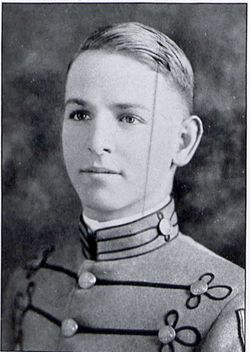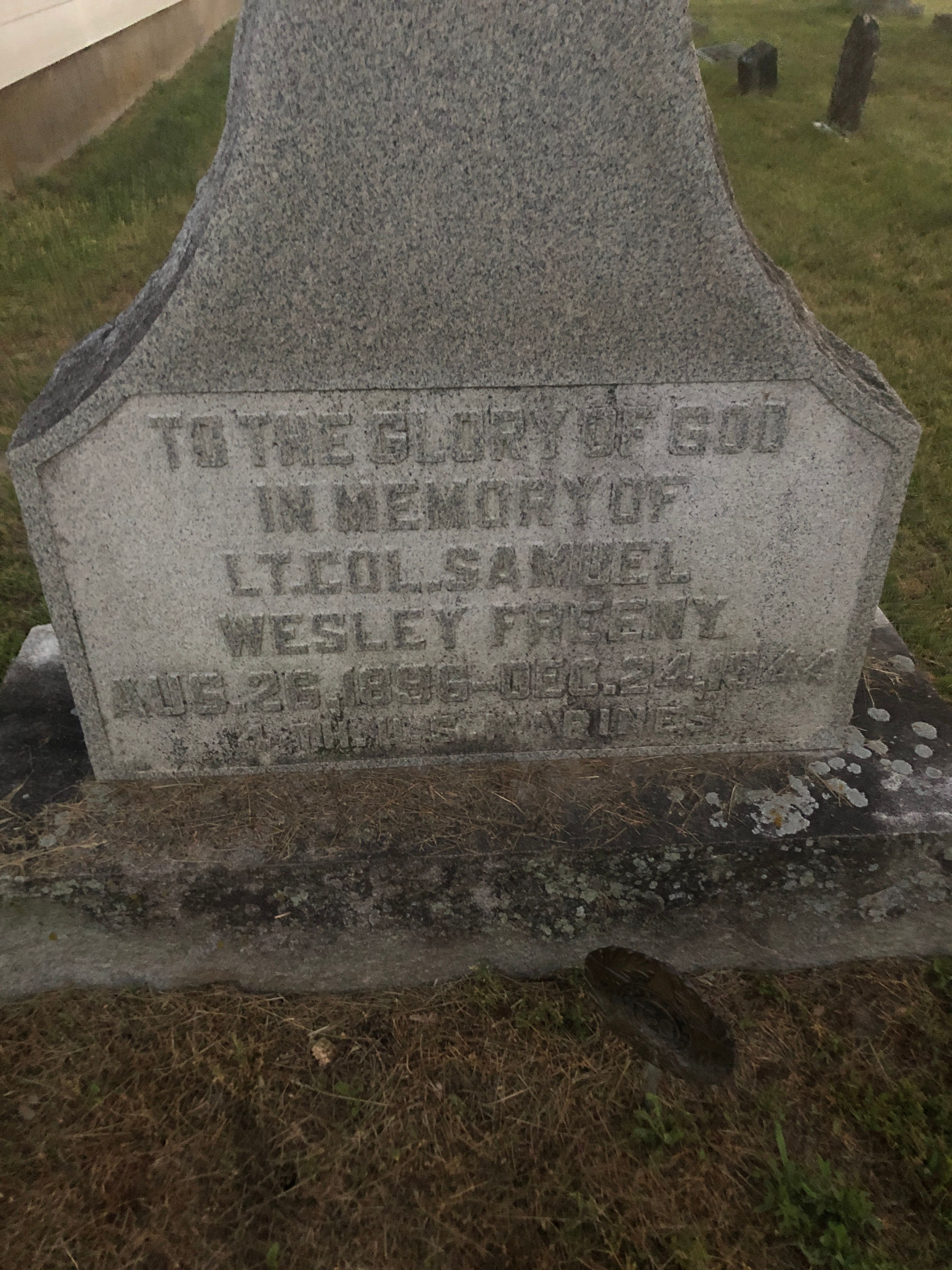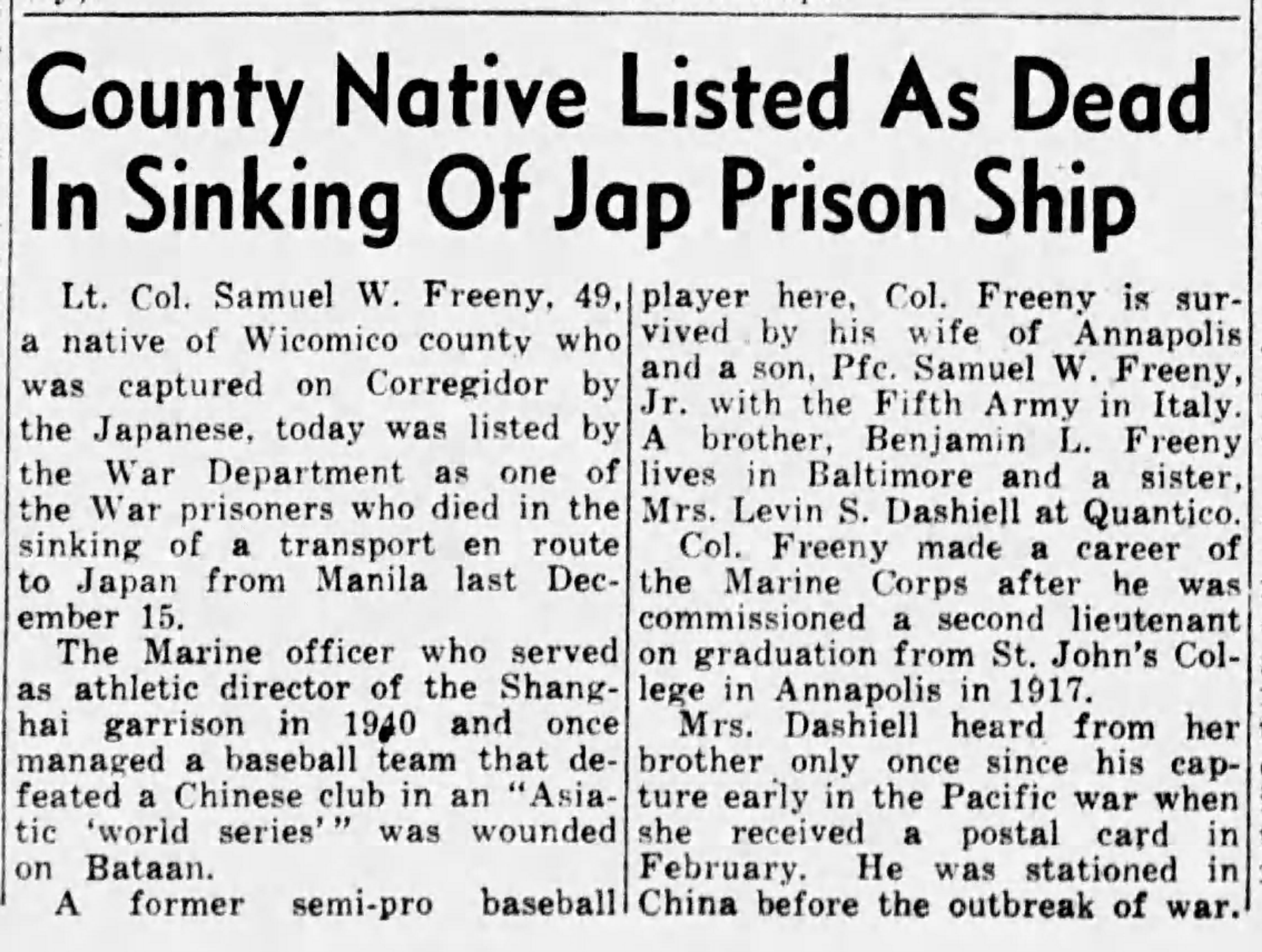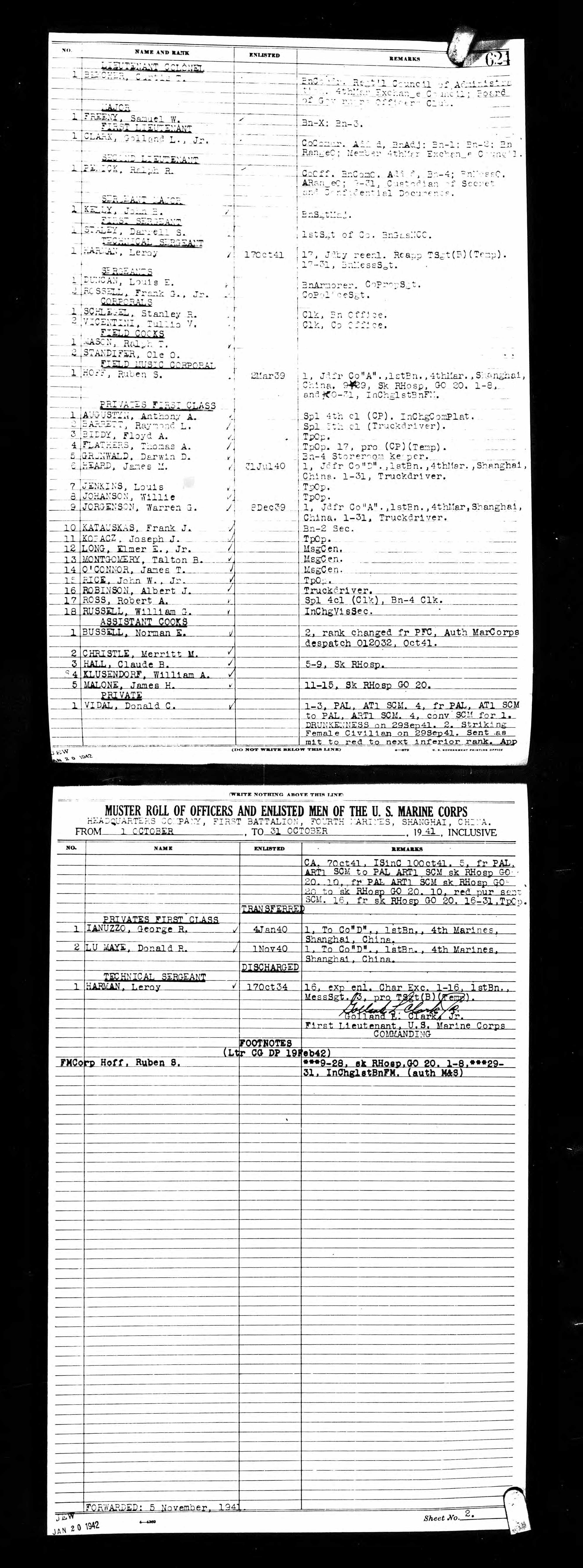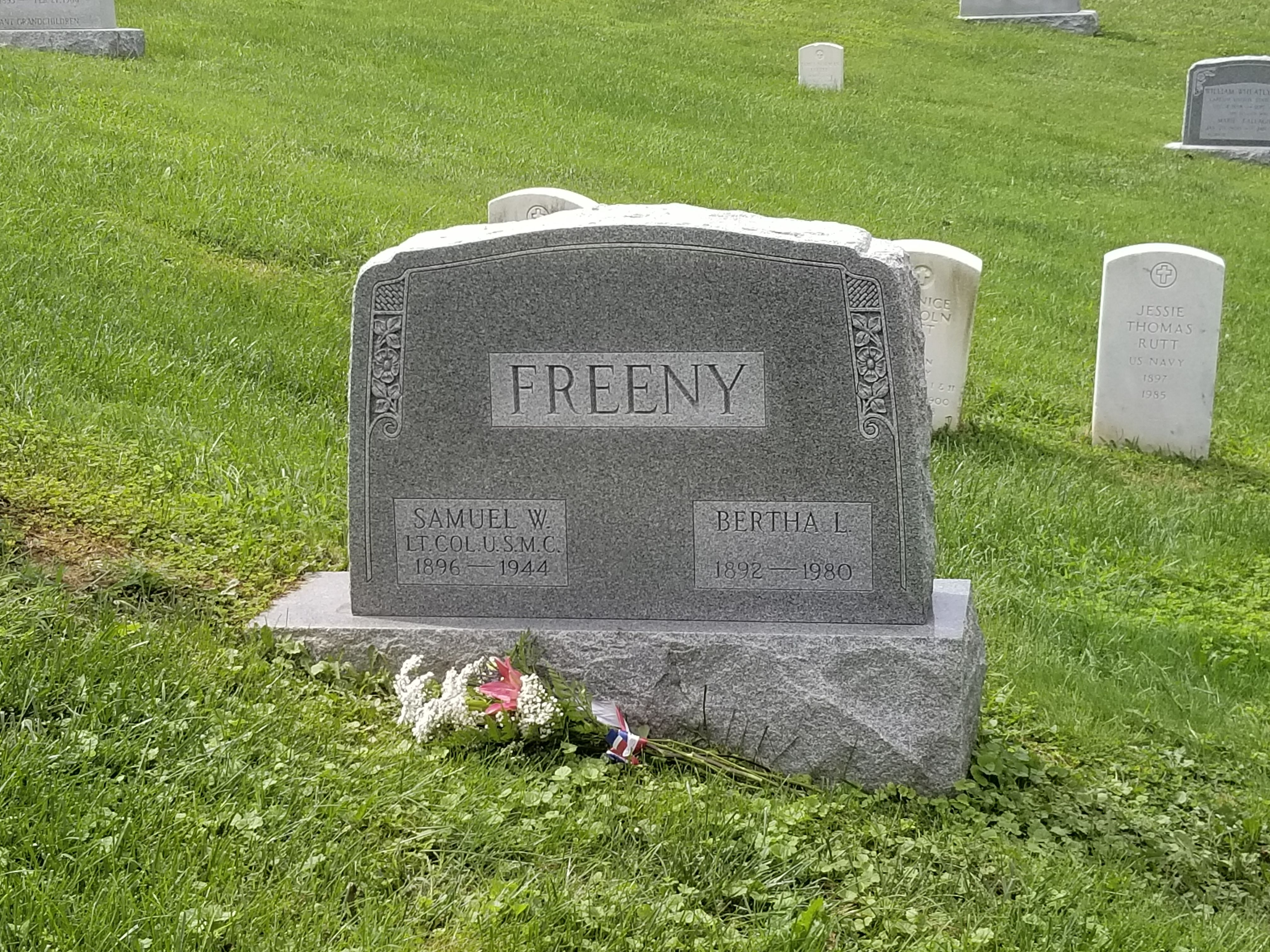The 1900 US Census shows the family as living in Delmar, Wicomico County, Maryland. Samuel's mother was a widow at this point. The following family members were living in the home at this time:
Head Martha A Freeny F 41 Delaware
Son Barton R Freeny M 17 Maryland
Son R Lee Freeny M 14 Maryland
Dau Bessie E Freeny F 10 Maryland
Son Samuel W Freeny M 4 Maryland
Sam was the husband of Bertha S. Obery who he married in Maryland, and was the father of a son, Samuel W. Freeny, Jr, (he would actually have been the third).
Sam was commissioned an Officer of Marines effective 4/19/1917. His first assignment after he completed his officer training at Quantico, Virginia, was with the 93rd Company, 7th Marine Regiment, Deer Point, Guantanamo, Cuba. He had a distinguished career serving both stateside postings as well as overseas posts in the Haiti, back to Cuba, Philippines and China. He steadily rose in rank and was a Lieutenant Colonel by 1941 stationed in China.
In November, 1941, orders were given for the 4th Marine Regiment to depart from Shanghai, China, where they had been operating for the previous 15 years. This departure was due to the growing Japanese military influence in the area and the fact that the marines were grossly outnumbered. The Regiment, consisting of two small battalions, a headquarters unit and the regimental band, left China on the 27th and 28th and sailed to the Philippines. LtCol Freeny was the Executive Officer of the regiment and was assigned to the Headquarters Company, 1st Battalion, 4th Marines (Commander was LtCol Curtis T. Beecher) and they were sent to the Marine Barracks, Olongapo Navy Yard, Philippines. At approximately 0300 hours on the morning of 12/8/1941, word was received of the Japanese attack on Pearl Harbor. Reveille was sounded and LtCol Freeny addressed the men of his unit while still in his nightshirt, about the attack and that the United States was at war with the Empire of Japan.
On 12/14/1941, Japanese bombers attacked the Olongapo/Subic Bay area. Ten days later, the order was given to burn the Subic Bay Navy Base and withdraw. Olongapo was set aflame in anticipation of Japanese troop arrival. The USS NEW YORK was scuttled in Subic Bay to prevent it from falling into Japanese hands. When the American forces made a last-ditch stand on the Bataan peninsula, the Naval Station was abandoned and most of its facilities were burned before the Japanese arrived. The 11,000 defenders fought bravely for 6 months with their final battle being conducted at Corregidor when they finally surrendered to the Japanese forces. LtCol Freeny had been wounded on 4/29/1942. During the battle at Corregidor, LtCol Freeny organized a platoon of men he gathered from the Malinta Tunnel, to reinforce the beleaguered 1st Battalion. One of the U.S. Army enlisted men he acquired complained, "I've never fired a rifle before. I'm in the finance department!" Freeny replied, "You just go out and draw their fire and the Marines will pick them off."
LtCol Freeny was captured by the Japanese after the fall of Corregidor, on 5/6/1942. After two years of imprisonment in the Philippines, the decision was made to move the POW's to Japan where they would basically be used as slave labor. The Oryoku Maru was a Japanese passenger cargo ship which was commissioned by the Imperial Japanese Navy during World War II as a troop transport and prisoner of war transport ship. Japanese POW transport ships are often referred to as "hell ships", due to their horrendous living conditions and the many deaths that occurred on board.
The Oryoku Maru left Manila on 12/13/1944, with 1,620 prisoners-of-war, mostly American, packed in the holds, and 1,900 Japanese civilians and military personnel in the cabins. As the ship neared the naval base at Olongapo in Subic Bay, US Navy planes from the USS HORNET attacked the unmarked ship damaging it. The Japanese civilians and troops were immediately evacuated back to shore. After two days, the Japanese told the POW's they had to take off their shoes and hats and swim to shore. Soon thereafter, American planes again attacked the ship, causing it to sink on 12/15/1944. At the time of the attack, about 100 prisoners had already died from suffocation or dehydration during the two nights at sea. Nearly 200 others were killed in the bombing or shot in the water as they tried to escape. The survivors of the sinking were held for several days in an open tennis court at Olongapo Naval Base. While there, the prisoners were afforded no sanitary conditions whatsoever. Prisoners experienced severe mistreatment, and several deaths occurred. The remaining prisoners were later transported by train to San Fernando, La Union. About 1,000 of the survivors were loaded on another Japanese ship, the Enoura Maru, while the rest boarded the smaller Brazil Maru. Both ships reached Takao (Kaohsiung) harbor in Taiwan on New Year's Day, where the smaller group of prisoners was transferred from Brazil Maru to Enoura Maru, and 37 British and Dutch were taken ashore. However, on January 9, the Enoura Maru was bombed and disabled while in harbor, killing about 350 men. The survivors were put aboard the Brazil Maru which arrived in Moji, Japan, on 1/29/1945. Only 550 of the 900+ who sailed from Taiwan were still alive. 161 more men died in Japan, Taiwan, and Korea in the coming months leaving only 403 survivors of the original 1620 to be liberated from camps in Kyushu, Korea, Manchuria, and Taiwan in August and September 1945. However, LtCol Freeny was not among them.
On 12/21/1944, while still housed in the POW camp at the Olongapo Naval Base, Col. Beecher and the POW doctor's, were ordered by the Japanese to select the 15 most ill prisoners for transport to Manila for medical care. One of those selected was Col. Beecher's XO, LtCol Freeny. He was very weak and was suffering from partial paralysis by this time and was the only Marine selected to go. The men were loaded up on a truck at 1900 hours on the 23rd and driven about two miles away from the camp to an old cemetery. A large pit had been dug and the men were forced to kneel at the edge of the pit and each one was bayoneted and/or beheaded and thrown into the pit. After the war the bodies were recovered and the families of those who could be identified were notified. LtCol Freeny's wife Bertha, requested that his remains be returned to the United States for burial at the U.S. Naval Academy, Annapolis, Maryland, were he now lies next to her (she died in 1980).
Lieutenant Colonel Samuel W. Freeny earned the following badges/decorations for his service during World War I and World War II:
- Combat Action Ribbon
- Purple Heart Medal with Gold Star (2nd Award)
- Prisoner of War Medal
- China Service Medal
- Marine Corps Expeditionary Medal
- American Defense Service Medal with device
- Asiatic-Pacific Campaign Medal with bronze battle/campaign star(s)
- World War I Victory Medal
- World War II Victory Medal
- Philippine Defense Medal with bronze campaign star
- Philippine Presidential Unit Citation Ribbon
- Marine Corps Marksmanship Badge
The 1900 US Census shows the family as living in Delmar, Wicomico County, Maryland. Samuel's mother was a widow at this point. The following family members were living in the home at this time:
Head Martha A Freeny F 41 Delaware
Son Barton R Freeny M 17 Maryland
Son R Lee Freeny M 14 Maryland
Dau Bessie E Freeny F 10 Maryland
Son Samuel W Freeny M 4 Maryland
Sam was the husband of Bertha S. Obery who he married in Maryland, and was the father of a son, Samuel W. Freeny, Jr, (he would actually have been the third).
Sam was commissioned an Officer of Marines effective 4/19/1917. His first assignment after he completed his officer training at Quantico, Virginia, was with the 93rd Company, 7th Marine Regiment, Deer Point, Guantanamo, Cuba. He had a distinguished career serving both stateside postings as well as overseas posts in the Haiti, back to Cuba, Philippines and China. He steadily rose in rank and was a Lieutenant Colonel by 1941 stationed in China.
In November, 1941, orders were given for the 4th Marine Regiment to depart from Shanghai, China, where they had been operating for the previous 15 years. This departure was due to the growing Japanese military influence in the area and the fact that the marines were grossly outnumbered. The Regiment, consisting of two small battalions, a headquarters unit and the regimental band, left China on the 27th and 28th and sailed to the Philippines. LtCol Freeny was the Executive Officer of the regiment and was assigned to the Headquarters Company, 1st Battalion, 4th Marines (Commander was LtCol Curtis T. Beecher) and they were sent to the Marine Barracks, Olongapo Navy Yard, Philippines. At approximately 0300 hours on the morning of 12/8/1941, word was received of the Japanese attack on Pearl Harbor. Reveille was sounded and LtCol Freeny addressed the men of his unit while still in his nightshirt, about the attack and that the United States was at war with the Empire of Japan.
On 12/14/1941, Japanese bombers attacked the Olongapo/Subic Bay area. Ten days later, the order was given to burn the Subic Bay Navy Base and withdraw. Olongapo was set aflame in anticipation of Japanese troop arrival. The USS NEW YORK was scuttled in Subic Bay to prevent it from falling into Japanese hands. When the American forces made a last-ditch stand on the Bataan peninsula, the Naval Station was abandoned and most of its facilities were burned before the Japanese arrived. The 11,000 defenders fought bravely for 6 months with their final battle being conducted at Corregidor when they finally surrendered to the Japanese forces. LtCol Freeny had been wounded on 4/29/1942. During the battle at Corregidor, LtCol Freeny organized a platoon of men he gathered from the Malinta Tunnel, to reinforce the beleaguered 1st Battalion. One of the U.S. Army enlisted men he acquired complained, "I've never fired a rifle before. I'm in the finance department!" Freeny replied, "You just go out and draw their fire and the Marines will pick them off."
LtCol Freeny was captured by the Japanese after the fall of Corregidor, on 5/6/1942. After two years of imprisonment in the Philippines, the decision was made to move the POW's to Japan where they would basically be used as slave labor. The Oryoku Maru was a Japanese passenger cargo ship which was commissioned by the Imperial Japanese Navy during World War II as a troop transport and prisoner of war transport ship. Japanese POW transport ships are often referred to as "hell ships", due to their horrendous living conditions and the many deaths that occurred on board.
The Oryoku Maru left Manila on 12/13/1944, with 1,620 prisoners-of-war, mostly American, packed in the holds, and 1,900 Japanese civilians and military personnel in the cabins. As the ship neared the naval base at Olongapo in Subic Bay, US Navy planes from the USS HORNET attacked the unmarked ship damaging it. The Japanese civilians and troops were immediately evacuated back to shore. After two days, the Japanese told the POW's they had to take off their shoes and hats and swim to shore. Soon thereafter, American planes again attacked the ship, causing it to sink on 12/15/1944. At the time of the attack, about 100 prisoners had already died from suffocation or dehydration during the two nights at sea. Nearly 200 others were killed in the bombing or shot in the water as they tried to escape. The survivors of the sinking were held for several days in an open tennis court at Olongapo Naval Base. While there, the prisoners were afforded no sanitary conditions whatsoever. Prisoners experienced severe mistreatment, and several deaths occurred. The remaining prisoners were later transported by train to San Fernando, La Union. About 1,000 of the survivors were loaded on another Japanese ship, the Enoura Maru, while the rest boarded the smaller Brazil Maru. Both ships reached Takao (Kaohsiung) harbor in Taiwan on New Year's Day, where the smaller group of prisoners was transferred from Brazil Maru to Enoura Maru, and 37 British and Dutch were taken ashore. However, on January 9, the Enoura Maru was bombed and disabled while in harbor, killing about 350 men. The survivors were put aboard the Brazil Maru which arrived in Moji, Japan, on 1/29/1945. Only 550 of the 900+ who sailed from Taiwan were still alive. 161 more men died in Japan, Taiwan, and Korea in the coming months leaving only 403 survivors of the original 1620 to be liberated from camps in Kyushu, Korea, Manchuria, and Taiwan in August and September 1945. However, LtCol Freeny was not among them.
On 12/21/1944, while still housed in the POW camp at the Olongapo Naval Base, Col. Beecher and the POW doctor's, were ordered by the Japanese to select the 15 most ill prisoners for transport to Manila for medical care. One of those selected was Col. Beecher's XO, LtCol Freeny. He was very weak and was suffering from partial paralysis by this time and was the only Marine selected to go. The men were loaded up on a truck at 1900 hours on the 23rd and driven about two miles away from the camp to an old cemetery. A large pit had been dug and the men were forced to kneel at the edge of the pit and each one was bayoneted and/or beheaded and thrown into the pit. After the war the bodies were recovered and the families of those who could be identified were notified. LtCol Freeny's wife Bertha, requested that his remains be returned to the United States for burial at the U.S. Naval Academy, Annapolis, Maryland, were he now lies next to her (she died in 1980).
Lieutenant Colonel Samuel W. Freeny earned the following badges/decorations for his service during World War I and World War II:
- Combat Action Ribbon
- Purple Heart Medal with Gold Star (2nd Award)
- Prisoner of War Medal
- China Service Medal
- Marine Corps Expeditionary Medal
- American Defense Service Medal with device
- Asiatic-Pacific Campaign Medal with bronze battle/campaign star(s)
- World War I Victory Medal
- World War II Victory Medal
- Philippine Defense Medal with bronze campaign star
- Philippine Presidential Unit Citation Ribbon
- Marine Corps Marksmanship Badge
Family Members
Other Records
Sponsored by Ancestry
Advertisement
Explore more
Sponsored by Ancestry
Advertisement
